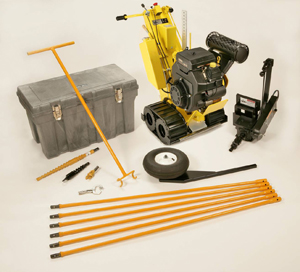During the installation of sprinkler systems or outdoor lighting it is not uncommon to meet up with obstacles that prevent the installer from continuing on.
These obstacles such as driveways or sidewalks can pose a formidable barrier. The expense of digging up concrete, asphalt or even bricks and stones and them replacing them can be more than the rest of the project combined.
There are ways to get under the obstacle that are usually much less expensive than digging it up and replacing it.
The technique is called:
Horizontal Boring or Horizontal Drilling
If you are confronted with a sidewalk a 3 to 6 foot obstacle, you can generally manually horizontal bore under the sidewalk using a garden hose and a piece of 1/2 inch steel pipe.
- Bring the trench, that you are digging, up to the obstacle.
- On the opposite side of the obstacle dig out an area approximately 8 inches square and a couple of inches lower than the trench depth. You want the opposite side a little lower in order to provide room should the steel pipe bore at a slight downward angle as shown in Figure 1.

Figure 1 - Trench construction for horizontal boring under a sidewalk
- Connect a garden hose to a piece of 1/2 inch steel pipe that is a minimum of 6 inches longer than the obstacle that your are trying to bore under.
- Lay the pipe in the trench, turn on the water and push the pipe under the obstacle, as shown in Figure 2. The water pressure should be such to blow the earth in its path away. Continue to push on the steel rod until it punctures the opposite side trench wall under the obstacle.
Note: The hole made by the water pressure will be much larger than the 1/2 inch pipe.

Figure 2 - Pipe laid in trench for horizontal boring using water pressure
- For best results it is wise to put a 2″, schedule 80, PVC pipe in the bore hole, even if you are running pipe or electrical conduit, as shown in Figure 3. Tape the end, using electrical or duct tape, of a piece of conduit approximately 1 foot longer than the obstacle (this will allow the conduit to protrude 6 inches on each side of the obstacle).

Figure 3 - 2″, schedule 80, PVC pipe in the bore hole under sidewalk
- Insert the item (sprinkler pipe, wires, electrical conduit, etc.) into the 2″ PVC pipe and pull through to the opposite side.
- Back-fill as required. Make sure to back-fill below the 2 inch PVC pipe.
If your obstacle is wide, such as a two car driveway, the aforementioned method may not be suitable due to compacted soil or logistics.
In that case you will need to rent a horizontal boring machine. These machines are available at most rental facilities.
The machines come in a variety of sizes, but for the homeowner a walk-behind machine is usually quite adequate to do the job.

Horizontal boring illustration is supplied courtesy of www.maxibore.com

